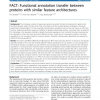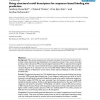151 search results - page 20 / 31 » Classifying protein sequences using hydropathy blocks |
GECCO
2009
Springer
13 years 11 months ago
2009
Springer
Since the genomics revolution, bioinformatics has never been so popular. Many researchers have investigated with great success the use of evolutionary computation in bioinformatic...
BMCBI
2010
13 years 7 months ago
2010
Background: The increasing number of sequenced genomes provides the basis for exploring the genetic and functional diversity within the tree of life. Only a tiny fraction of the e...
BMCBI
2007
13 years 7 months ago
2007
Background: Many protein sequences are still poorly annotated. Functional characterization of a protein is often improved by the identification of its interaction partners. Here, ...
ICASSP
2007
IEEE
13 years 11 months ago
2007
IEEE
Motion estimation is the most time-consuming subsystem in a video codec. Thus, more efficient methods of motion estimation should be investigated. Real video sequences usually exh...
GCB
2004
Springer
14 years 1 months ago
2004
Springer
: We introduce the novel concept of graph alignment, a generalization of graph isomorphism that is motivated by the commonly used multiple sequence alignments. Graph alignments and...


